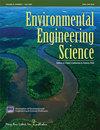Phosphate-Based Corrosion Inhibition in Drinking Water Systems and Effects on Disinfectant Decay and Biofilm Growth
IF 1.8
4区 环境科学与生态学
Q4 ENGINEERING, ENVIRONMENTAL
引用次数: 1
Abstract
Disinfectant decay by biofilms in distribution networks during stagnation can allow opportunistic pathogens' transmission and thus compromise drinking water safety. Applying phosphate-based corrosion inhibitors to the system can exacerbate disinfectant decay by providing nutrients to biofilms growing inside premise plumbings. In this study, we evaluate the impacts of corrosion inhibitors on biofilms' structural and chemical properties that form in premise plumbing, and the resulting implications for disinfectant decay. Two commonly used phosphate-based (phosphate blends and phosphate) corrosion inhibitors were added separately to simulated drinking water for biofilm development over 1 to 2 years. Optical coherence tomography (OCT) imaging showed that the studied biofilms' thickness, porosity, and porous structure did not change after exposure to free chlorine for 24 h or monochloramine for 120 h. Compared with groundwater biofilms, phosphate-based biofilms had the highest overall porosity due to their many connecting channels. The phosphate-based biofilms consumed free chlorine or monochloramine at a faster rate than groundwater biofilms. Experimental results showed that phosphate-based biofilms consumed more monochloramine after 96 h of contact than other biofilms. A separate set of experiments involving disinfectant decay with suspended biomass material, together with the OCT results, provided parameters for a simplified quasi-first-order reaction–diffusion model so that predictive modeling of decay in biofilms under stagnation conditions could be attempted without parameter fitting. The biofilm modeling results provided a close estimate for free chlorine decay while underestimating monochloramine decay. In agreement with the experimental results, the model results indicate that the phosphate-based biofilms led to slightly faster free chlorine consumption and monochloramine consumption than groundwater biofilms and indicate that diffusion limitation imposed by biofilm pore structure on disinfectant decay is important. The study results suggest that using phosphate-based corrosion inhibitors may lead to a rapid depletion of residual disinfectant during stagnation in the presence of biofilms.磷酸盐在饮用水系统中的缓蚀作用及其对消毒剂腐烂和生物膜生长的影响
在停滞期间,分配网络中的生物膜对消毒剂的腐蚀可使机会性病原体传播,从而危及饮用水安全。在系统中使用磷酸盐基缓蚀剂可以通过为室内管道内生长的生物膜提供营养物质来加剧消毒剂的腐烂。在这项研究中,我们评估了腐蚀抑制剂对室内管道中形成的生物膜的结构和化学性质的影响,以及由此产生的消毒剂衰变的影响。两种常用的磷酸盐基(磷酸盐混合物和磷酸盐)缓蚀剂分别添加到模拟饮用水中,用于1至2年的生物膜发育。光学相干层析成像(OCT)显示,在游离氯作用24 h或单氯胺作用120 h后,所研究的生物膜的厚度、孔隙度和孔隙结构没有发生变化。与地下水生物膜相比,磷酸盐基生物膜由于其连接通道较多,整体孔隙度最高。磷酸盐基生物膜比地下水生物膜消耗游离氯或单氯胺的速度更快。实验结果表明,磷酸盐基生物膜在接触96 h后消耗的单氯胺比其他生物膜多。另一组涉及悬浮生物质材料的消毒剂衰变的实验,连同OCT结果,为简化的准一级反应-扩散模型提供了参数,以便可以在没有参数拟合的情况下尝试在停滞条件下对生物膜中的衰变进行预测建模。生物膜模拟结果提供了一个接近的估计游离氯的衰变,而低估了单氯胺的衰变。与实验结果一致,模型结果表明,磷酸盐基生物膜的游离氯消耗和单氯胺消耗略快于地下水生物膜,表明生物膜孔结构对消毒剂衰变的扩散限制是重要的。研究结果表明,使用磷酸盐基缓蚀剂可能导致残留消毒剂在生物膜存在的停滞期间迅速耗竭。
本文章由计算机程序翻译,如有差异,请以英文原文为准。
求助全文
约1分钟内获得全文
求助全文
来源期刊

Environmental Engineering Science
环境科学-工程:环境
CiteScore
3.90
自引率
5.60%
发文量
67
审稿时长
4.9 months
期刊介绍:
Environmental Engineering Science explores innovative solutions to problems in air, water, and land contamination and waste disposal, with coverage of climate change, environmental risk assessment and management, green technologies, sustainability, and environmental policy. Published monthly online, the Journal features applications of environmental engineering and scientific discoveries, policy issues, environmental economics, and sustainable development.
 求助内容:
求助内容: 应助结果提醒方式:
应助结果提醒方式:


